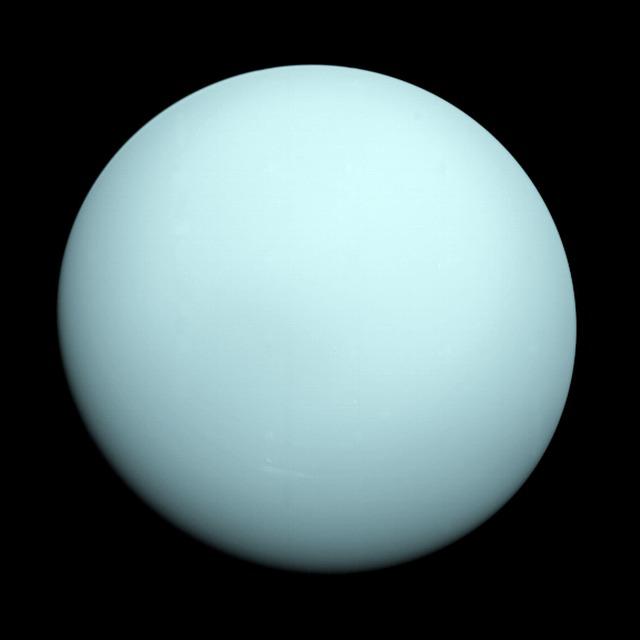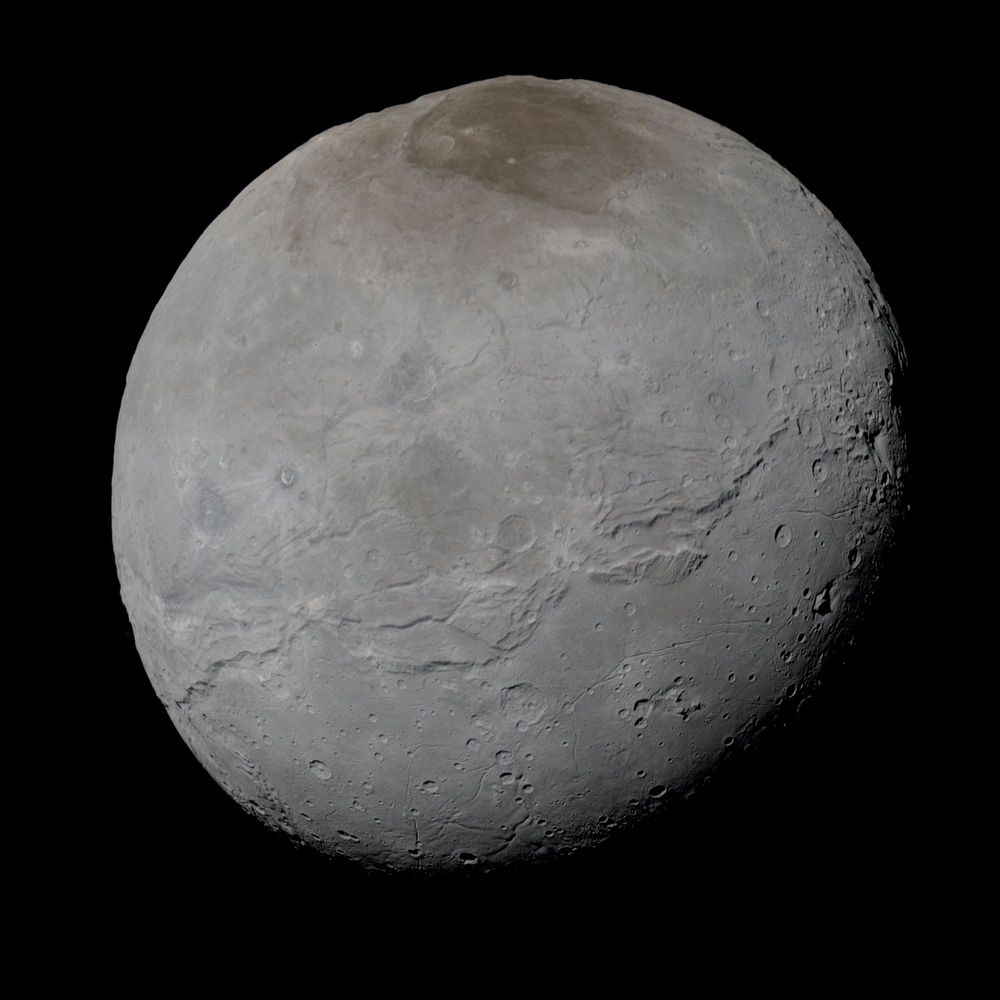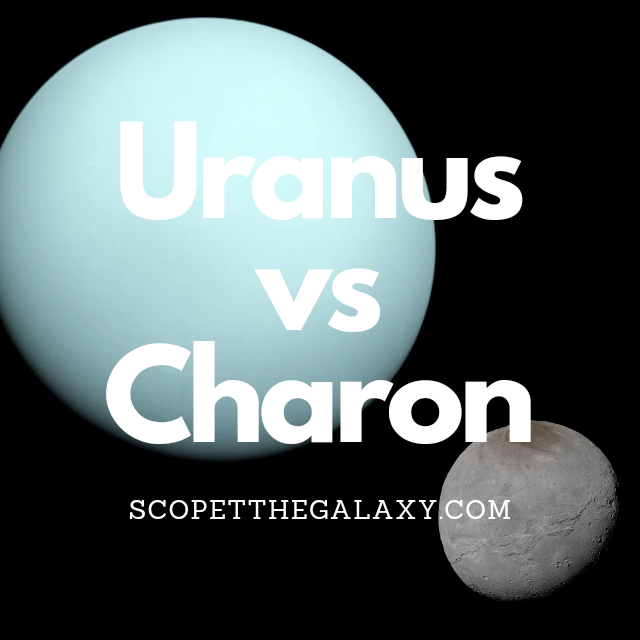*This post may contain affiliate links. This means we may make a commission if you purchase an item using one of our links*
The main differences between Uranus and Charon is that Uranus is an ice based gas giant and the 3rd largest planet in the solar system with a diameter of 50,724km whereas Charon is Pluto’s largest moon with a diameter of 1,212km, Uranus has 27 moon whilst Charon has 0 and Charon is a low density terrestrial based entity whilst Uranus is gas based, composed of hydrogen, helium and methane.
There are various other differences between these two so, continue reading for a more detailed look at each of these celestial bodies along with their similarities below.
What Is The Planet Uranus?
Table of Contents

Uranus is the 7th farthest planet from the Sun and the 3rd largest planet in our solar system, coming in at a diameter of 50,724 km. This means that roughly 63 Earth’s could fit inside this ice giant.
In regards to why this cyan blue planet is referred to as an ice giant, it’s down to it’s composition. Uranus is made mostly of methane, ammonia and water with its atmosphere mostly consisting of hydrogen and helium, much like the Sun, and the other giant planets in our solar system.
Due to its distance from the Sun, it takes Uranus 84 years to complete one orbit our central star, whereas it’s axial rotation is much faster than even our Earth at 17 hours per rotation.
As a result of its distance from the Sun, ice based composition and faster rotation levels, Uranus is far from an ideal place to live in let alone have the potential to support life.
Its base temperature is generally a chilling -190 to -200 degrees Celsius and its rocky core, although hot, is still on the cooler side for a large planet sitting around the 5,000 degrees Celsius range.
The planet’s winds are also very fast often hitting 900 km/h, which is roughly twice that of Earth’s most powerful turbulent wind speeds.
In regards to the moons surrounding this cyan planet, we’ve discovered 27 small ones orbiting it. Furthermore, it has 13 rings surrounding it which also means Uranus has the most abundant collection of rings surrounding in our solar system, which is even more than Saturn.
One of the Uranus’ most unique features would include the manner in which it rotates around its axis. As opposed to the slightly angled rotation that the likes of Earth, Saturn and most other planets display, Uranus’ axis is positioned at a 98 degree angle.
What this means is this ice giant completes an axial rotation on its side as opposed to the relatively up straight positioning of most of the other planets in our solar system.
What Is The Moon Charon?

Charon is the largest of Pluto’s moons, first discovered on 22nd June 1978. The surface of this icy world is frozen with nitrogen and methane ice; it may also hold some water ice. While Pluto possesses a reddish hue, Charon is closer to a neutral shade of grey; this suggests the two bodies have different compositions.
Scientists named this moon after the mythical ferryman, Charon, who once carried souls across the Acheron river. This river is one of five legendary rivers that could lie beneath the surface of Pluto.
The formation of Charon remains something of a mystery to scientists. However, this moon may have formed around 4.5 billion years ago when an object traveling at immense speed collided with Pluto. Its average distance from the Sun is approximately 3.6 billion km.
Charon is almost half the size of its planet at 1,212km, where scientists refer to these two bodies as a “double dwarf planet system,” and the chilly temperatures vary from minus 23 to minus 258 degrees Celsius.
Charon takes 153 hours to orbit its planet at an average distance of 19,640km, and it is tidally locked, meaning the same side of the moon always faces Pluto. Pluto also experiences a tidal lock to Charon, so the same two sides always face one another.
Among the fascinating features of this ice moon are the ice volcanoes that could exist on the surface. Observations from the Gemini observatory suggest that Charon could have a form of cryovolcanism known as ice-particle geysers.
The frigid world also has a canyon between seven and nine kilometers deep. (To put that into perspective, Mount Everest has a height of 8.8km).
Similarities Between Charon And Uranus
There are a few similarities that Uranus and Charon share, which in this case includes the following:
- Both are a spherical shape.
- Both have a hotter core.
- Both are part of the same solar system.
- Neither have tectonic plates.
- Both orbit another object.
Differences Between Charon And Uranus
In regards to the differences between the two, they include the following:
- Charon is smaller with a diameter 1,212km compared to Uranus that has a diameter of 50,724km.
- Uranus is an ice based gas giant planet whilst Charon is a natural satellite.
- Uranus orbits the Sun in an almost circular pattern whilst Charon orbits Pluto and the Sun elliptically.
- A day on Uranus takes 17 hours whilst a day on Charon is 153 hours.
- Uranus orbits the Sun in 84 years whilst Charon orbits the Sun in 247.78 years.
- Uranus has an axial tilt of 98 degrees whilst Charon’s axial tilt is straighter and close to 0 in comparison.
- Charon’s average temperature is -23 to -253 degrees whilst Uranus’ average is -190 to -200 degrees Celsius.
- Charon’s atmosphere is near enough non-existent whilst Uranus is an ice based gas giant composed of hydrogen, helium and methane.
- Charon’s gravity is 0.288 m/s² compared to Uranus’ that is 8.87 m/s².
- Uranus has a mass of 8.681 × 10^25 kg whilst Charon’s mass is 1.58×10^21 kg.
- Charon has a density of 1.71 g/cm³ whilst Uranus’ density is 1.27 g/cm³.
- Uranus has a magnetosphere whilst Charon does not.
- Uranus has 27 moons whilst Charon has 0.
- Uranus has 13 Rings surrounding it whilst Charon has 0.
- Charon is tidally locked to Pluto whilst Uranus is not tidally locked to anything.
Summary
Even if Uranus and Charon are part of the same solar system, the two are ultimately designed to function very differently from one another.
Whether it be in regards to Uranus being an ice based gas giant whilst Charon is a low density natural satellite, their distances from the Sun, temeprature differences and more, Uranus and Charon are worlds apart in regards to how they function as a whole

